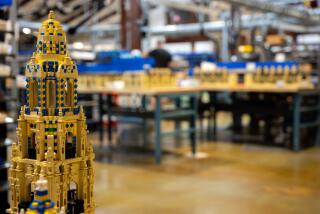With High-Tech Toys, Lego Is Building for the Future
- Share via
In a bid to recapture kids’ imaginations, decidedly low-tech Lego is taking its building blocks high-tech.
Lego Group will marry its construction sets with computers this fall when it introduces a series of software titles based on Lego themes, as well as a programmable brick that lets kids build lifelike robots.
“The enjoyment children derive from Lego in the physical world can be split into two areas: first, in constructing the models, and second, in the chance to use their imagination,” said Mark Livingstone, worldwide managing director of Lego Media International. “In the virtual world, we can extend children’s enjoyment by bringing their constructions to life and enabling them to explore the world they have created with a limitless supply of virtual bricks.”
For the 66-year-old Danish toy maker, the move marks its boldest step since going from wood to plastic blocks in 1947. Lego hopes combining its traditional toy lines with technology will regenerate interest in its colorful bricks while helping it stay competitive in the 21st century. The company’s effort will be led by London-based Lego Media, which is charged with developing video games, and Enfield, Conn.-based Lego MindStorms, developer of programmable robots.
The new products represent an “evolution rather than a revolution,” according to company officials, who hope the new products will mean greater sales in the U.S., where nearly two-thirds of households with kids under 15 own at least one set, according to the company.
Lego’s new products take advantage of the growing popularity of home computers by allowing users to interact with their static creations. For instance, a game called Lego Creator lets users go inside the homes or vehicles they have created from three-dimensional computer-animated bricks. They will also be able to share their designs at the company’s Web site at https://www.lego.com.
Lego MindStorms, released this month, also relies on a computer to animate its robots. The set--expected to retail for about $200--comes with 700 Lego pieces, light and touch sensors, Windows-based software and an oversize Lego block that contains a small computer.
The product is aimed at kids 12 and older who can use computer software to program the battery-operated brick, known as the RCX unit, by clicking, dragging and stacking virtual Lego blocks. The PC then beams this information into the RCX unit via an infrared signal.
Two additional MindStorms sets--Extreme Creatures and Robo Sports--will be released this month. A third, Exploration Mars, will be released in the spring.
Mitchel Resnick, a professor at the MIT Media Laboratory who has spent the better part of the last 14 years working with Lego to develop the MindStorms products, said the RCX unit allows kids to build behavior into their Lego models. This extends learning opportunities and helps kids distinguish between how a machine acts and, say, how an animal would act, Resnick said.
“This gives kids a much greater sense of control. A lot of toys on the market have some electrical element built into them, like flashing lights or beeps, but don’t give a great sense of control,” Resnick said.
Computerized bricks developed for the MindStorms project are in line with a trend toward embedding computers in everything from household appliances to consumer electronics to toys, Resnick said.
Tapping into this trend should keep Lego fresh--even though its products have been on store shelves since Franklin D. Roosevelt was president. The largest manufacturer of construction toys in the world was born in 1932 when Ole Kirk Christiansen began making wooden buses, animals and piggy banks. In 1934, he named his business Lego, a contraction of two Danish words, leg godt, or “play well.” Christiansen’s grandson, Kjeld Kirk Kristiansen, now runs the closely held company from its headquarters in Billund, Denmark.
For years, Lego could rely on steady sales as it expanded into new markets and broadened its seasonal themes. But this changed in the early 1990s, when new competitors such as K’Nex Industries and Ritvik’s Megablocks entered the market.
Increased price pressures from imitators forced Lego to rethink its marketing strategy and diversify its business. The company is branching into not only software and computer products, but also, beginning next year, launching a cartoon series, theme parks and licensing deals with LucasArts and Walt Disney.
Early research on the new products has shown that people who use them “go back to the boxes of Lego bricks they have and pull them out and start using them some more,” said Linda Dalton, director of Lego MindStorms. Lego Media plans to release three games in November--Lego Creator, Lego Loco and Lego Chess. Lego Loco lets young builders design a train, and Lego Chess features characters from Lego’s Western, pirates and adventure sets.
In 1999, the company plans to release titles that include Legoland, which lets kids design, construct and operate a virtual theme park; Lego Racers, the company’s first game for Nintendo 64 and Sony PlayStation; and Lego Friends, Lego Media’s first game designed for girls.
The new software will have lots of competition in the “edutainment” market--a blend of entertainment and educational titles. The company’s well-known brand may be an asset in the struggle for name recognition in this category, analysts say.
But dressing up toys with high-tech wizardry won’t help overcome the perception that they’re toys, said George Carey, president of Just Kid Inc., a Stamford, Conn.-based market research firm.
“The overall trend driving the interest in merging toys with technology is the increasingly younger age that children are leaving popular toys,” Carey said. “If you look at Lego’s appeal, by age 7 there’s a tremendous drop-off. The reality is that not many 11-year-olds would be caught dead showing up with a box of Legos under their arm.”
*
Times staff writer Jennifer Oldham can be reached via e-mail at jennifer.oldham@latimes.com.
More to Read
The biggest entertainment stories
Get our big stories about Hollywood, film, television, music, arts, culture and more right in your inbox as soon as they publish.
You may occasionally receive promotional content from the Los Angeles Times.










